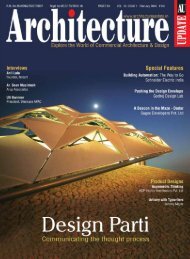Unfolding Narratives
Create successful ePaper yourself
Turn your PDF publications into a flip-book with our unique Google optimized e-Paper software.
Special Feature<br />
rainwater harvesting<br />
Marking a Sustainable Future<br />
Rainwater Harvesting is more about a need for<br />
planning and incorporating systems at the<br />
construction stage than mere high technology<br />
Anurag Yadav<br />
March 22 is celebrated globally as World Water Day. In<br />
India, this day needs to be marked with still greater<br />
emphasis for obvious reasons. Water scarcity in Delhi,<br />
Mumbai and other metros is appalling and the crisis in smaller<br />
towns can be critical indeed. With increasing worldwide focus on<br />
climate change it is no wonder that sustainable initiatives such as<br />
water harvesting comes centre stage. A typical commercial<br />
rainwater harvesting system in one building can save millions of<br />
liters of municipal drinking water each year. That savings could<br />
quickly add up to billions of liters per year if public and private<br />
buildings are enforced, incentivised or encouraged towards it.<br />
Now let’s face the facts. Few private buildings and government<br />
buildings too, barely spared a serious thought for water harvesting.<br />
So far it has been a localised sporadic effort because closely linked<br />
to rainwater harvesting is the issue of reusing grey water.<br />
There have been many but one example of the country’s previous<br />
first citizen will illustrate it best. In November 1998, the then-<br />
President of India K R Narayanan evinced interest in harvesting<br />
water at the Rashtrapati Bhavan campus which covers 1.33 sq.<br />
kms. The total demand was about 2 million liters of water per day.<br />
This demand was met through the New Delhi Municipal<br />
Corporation supply and the estates own borewells.<br />
Since about 35% of the water requirements were being met through<br />
groundwater sources, there had been an alarming decline of<br />
groundwater levels in the estate. Simply by diverting rainwater<br />
from the northern side of roof and paved areas surrounding<br />
Rashtrapati Bhavan to an underground storage tank of 1 lakh litre<br />
capacity a substantial saving was made. Recharge shafts were<br />
constructed in the staff residential areas and a dramatic rise in<br />
water tables was noticed in a few years.<br />
Today, it is a still more commercially sensible decision to invest in<br />
rainwater harvesting technologies in commercial and private<br />
buildings. In fact rainwater harvesting and grey water reusage<br />
should go in step.<br />
Architecture Update March 2016 19








![40-41] Book Review_Sourabh Gupta](https://img.yumpu.com/56720840/1/190x253/40-41-book-review-sourabh-gupta.jpg?quality=85)







